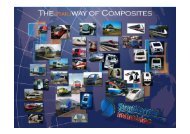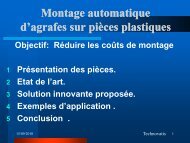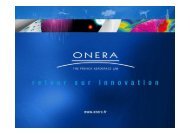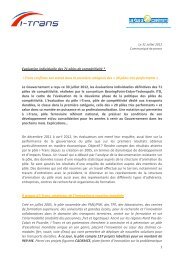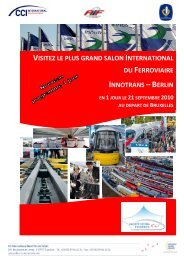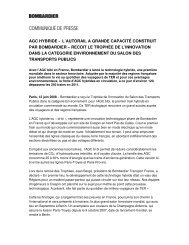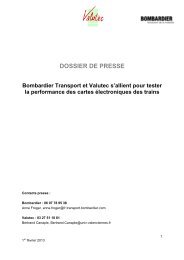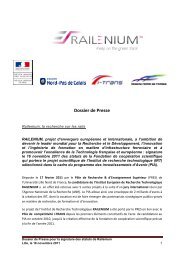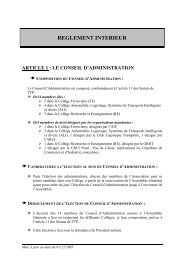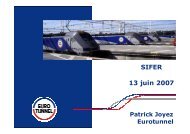RAILENIUM - I-Trans
RAILENIUM - I-Trans
RAILENIUM - I-Trans
Create successful ePaper yourself
Turn your PDF publications into a flip-book with our unique Google optimized e-Paper software.
Rail Industry Mee0ng<br />
Professeur Abdelhakim ARTIBA, VP Recherche Université de<br />
Valenciennes<br />
Luce?e Vanlaecke,, Directrice Régionale RFF
PRESENTATION SYNTHETIQUE DE <strong>RAILENIUM</strong><br />
– Technological Research InsCtute (IRT), with an European and<br />
InternaConal dimension ; its creaCon is an answer to the compeCCveness<br />
requirements related to the highly evolving market condiCons of the rail<br />
industry<br />
– It is organised under the terms of a FoundaCon leading the R&D<br />
programmes and those of a SAS (Simplified Joint Stock Company)<br />
managing a tesCng staCon (centre)<br />
– Its governance is done jointly by the industrial companies, the research<br />
and higher educaCon public organisaCons (universiCes) and the local<br />
collecCviCes<br />
– The main objecCve is to produce technical innovaCon for rail<br />
infrastructures and to accelerate the market introducCon of new<br />
products<br />
– It will develop educaConal programmes suited to industrial<br />
requirements and needs<br />
– It authors a main site providing unique equipment and research<br />
frameworks at the European level (a 5km-‐long tesCng loop, tramway<br />
tracks, faCgue test circuits, etc.)
Research and Educa0on<br />
Ins0tu0ons members<br />
PRES Lille Nord de France<br />
(UVHC, USTL, UA, ECLille,<br />
EMDouai)<br />
IFSTTAR<br />
UTC<br />
which is, 8 members<br />
Members and partners<br />
Industrial members Partners<br />
RFF<br />
EUROTUNNEL<br />
SNCF<br />
ALSTOM<br />
GHH-‐VALDUNES<br />
BOUYGUES TP<br />
COLAS RAIL<br />
NORPAC<br />
ESI Group<br />
INEXIA<br />
RAILTECH<br />
SATEBA<br />
TATA STEEL<br />
VOSSLOH-‐COGIFER<br />
THALES S&S<br />
MERMEC France<br />
SETEC<br />
EGIS Rail<br />
i-‐<strong>Trans</strong><br />
which is, 19 members<br />
FIF FédéraCon des Industries Ferroviaires<br />
UIC<br />
AIF AssociaCon des Industriels du<br />
Ferroviaire (nord-‐pas de calais)<br />
CERTIFER<br />
EPSF<br />
STRMTG<br />
ICAM Lille<br />
PMEs :<br />
ADES<br />
AETECH<br />
GEOMNIA<br />
SOGEMA Engineering<br />
STRATIFORME<br />
which is, 11 partners
Main challenges for the IRT’s members and partners<br />
RFF and GI<br />
Industrial members<br />
(equipment suppliers,<br />
construc0on and public<br />
works providers)<br />
Research Centres<br />
Pôle I-‐TRANS<br />
Collec0vi0es<br />
• Reinforce infrastructure sustainability,<br />
• Develop new security and control funcConaliCes<br />
• Rethink homologaCon procedures in order to accelerate the<br />
infrastructure innovaCons development<br />
• Start building a long lasCng collaboraCon between all the parCes involved<br />
• Reduce costs and delays for placing new products on the market<br />
• Develop pre-‐compeCCve research<br />
• Develop public – private teams for confidenCal compeCCve research<br />
• Develop the R&D with industrial companies,<br />
• Take advantage from heavily equipped and innovaCve tesCng staCons<br />
• Develop the capability to make collaboraCve project proposals between<br />
different parCes of one of the fundamental sectors of the Pole,<br />
• Support and assist small and medium enterprises in their innovaCon process<br />
• Reinforce the regional sensiCvity to the rail industrial sector,<br />
• Develop private research in the region
What is the scope?<br />
- The track (platform, structures)<br />
- Energy supplies<br />
- Monitoring and Control system<br />
- Information systems<br />
- Exchange poles<br />
- Interfaces with the rolling stock<br />
What markets ?<br />
- Rail track development<br />
- Urban networks development<br />
- Rail networks maintenance and renewal<br />
<strong>RAILENIUM</strong> Posi0oning<br />
Ecosystem<br />
Infrastructure<br />
Managers<br />
Railway<br />
Companies<br />
Suppliers<br />
System Engineers<br />
Technology<br />
providers<br />
Regulators<br />
Research Centres
Ambitions<br />
AMBITION AND OBJECTIVES<br />
PosiConing as a world leader in R&D, innovaCon and<br />
educaConal engineering for the rail industry sector<br />
Objectives<br />
§� Increase the RAMS factor (Reliability –<br />
Availability – Maintainability -‐ Safety)<br />
§� Develop technologies and processes enabling<br />
flow capacity increase of exisCng<br />
infrastructures<br />
§� Reduce innovaCon development cycles (market<br />
accessibility) by reducing homologaCon delays<br />
§� Improve the rail industry environmental and<br />
social balance<br />
§� Develop a prospecCve vision upon the link<br />
between land planning and mobility<br />
A strategic and<br />
technologic<br />
roadmap<br />
• A more sustainable<br />
infrastructure<br />
• A safer, more efficient and<br />
more intelligent infrastructure<br />
• A more easily licensable<br />
infrastructure
8 Work Programs<br />
• DefiniCon of indicators and<br />
assessment methods<br />
• ConstrucCon of an<br />
infrastructure business model.<br />
Numerical models and<br />
virtual prototyping<br />
will be used for the<br />
facilitaCon of virtual pre-‐<br />
cerCficaCon<br />
WP8<br />
Economics<br />
WP7<br />
Pre-‐<br />
cerCficaCon<br />
• Increase wheel and rail durability<br />
• Reduce aggressiveness of wheel sets on the rail<br />
• Reduce rail noise<br />
• Link between process-‐microstructure-‐damage<br />
• Methodology for integrated design/producCon of<br />
composite structures<br />
• Development of “intelligent” composite parts and<br />
the usage of bio-‐/agro-‐sourced and recycled<br />
materials.<br />
WP1<br />
Materials<br />
WP6<br />
Applied IT<br />
• CollecCon and formaing of raw<br />
and expert data<br />
• Modelling of infrastructure<br />
condiCon<br />
• Test planning<br />
R&D<br />
• Ballast behaviour<br />
• Slab track<br />
• <strong>Trans</strong>iCons<br />
• Other<br />
WP2<br />
Civil<br />
engineering<br />
WP5<br />
TesCng and<br />
control<br />
engineering<br />
WP3<br />
Power<br />
management<br />
• Impact of power supply on<br />
tracCon and of tracCon on power<br />
supply<br />
• Energy storage<br />
• OpCmizaCon of electrificaCon<br />
systems for EMC<br />
• Energy interacCon in mobile<br />
power supply<br />
WP4<br />
Intelligent infra-‐<br />
vehicle<br />
interacCon<br />
• Rail and track supervision with geometric monitoring and<br />
mechanical data<br />
• Monitoring of track and structures with distributed acousCc<br />
sensors.<br />
• IntegraCon and autonomy of sensors/triggers for structures<br />
monitoring.<br />
• System to measure rail infrastructure emissions in a<br />
controlled electromagneCc environment.<br />
• OpCmize use of rail<br />
capaciCes<br />
• System approach of<br />
safety<br />
• OpCmize interoperability<br />
of signalling systems<br />
• Wireless communicaCons<br />
systems<br />
• LocalizaCon systems<br />
•Systems for detecCng<br />
hazardous infrastructure<br />
situaCons.
WP1<br />
Materials and<br />
processes<br />
• Increase wheel and rail durability<br />
• Reduce aggressiveness of wheel sets<br />
on the rail<br />
• Reduce rail noise<br />
• Link between process-‐<br />
microstructure-‐damage<br />
• Methodology for integrated design/<br />
producCon of composite structures<br />
• Development of “intelligent”<br />
composite parts and the usage of<br />
bio-‐/agro-‐sourced and recycled<br />
materials.<br />
R&D<br />
Task 1: Op0miza0on of the link between the development of materials and<br />
sustainability of infrastructure components<br />
-‐ PP 2: evoluCon of grades of steel for reduced wear and contact faCgue<br />
(2014)<br />
-‐ PC 1: opCmizaCon of connectors with catenary wires<br />
-‐ Task 2: Durability of vehicle– Infrastructure interfaces<br />
-‐ PC 2: electric insulaCon joint rails<br />
-‐ PC 3: rail welds<br />
Task 3: Reduc0on of noise resul0ng from contact<br />
-‐PP1: miCgaCon screeching noises (2013)<br />
Task 4: Cudng structures by developing new solu0ons based composites and<br />
materials with limited environmental footprint.
WP2<br />
Civil Engineering and<br />
Soil Mechanics<br />
• Ballast behaviour<br />
• Slab track<br />
• <strong>Trans</strong>iCons<br />
• Other<br />
R&D<br />
-‐ PP 3: Knowledge database<br />
Task 1: Design and construc0on of a rail fa0gue carrousel<br />
Detailed studies<br />
Task 2: Research on ballasted track<br />
-‐ PP 4: OpCmizaCon of ballasted track<br />
-‐ PC 4: Areas of transiCon<br />
Task 3: Research on slab track<br />
-‐ PC 5: RehabilitaCon of ancient ways in traffic tunnels
WP3<br />
Power management<br />
• Impact of power supply on<br />
tracCon and of tracCon on<br />
power supply<br />
• Energy storage<br />
• OpCmizaCon of<br />
electrificaCon systems for<br />
EMC<br />
• Energy interacCon in mobile<br />
power supply<br />
R&D<br />
The objecCve is to ensure a significant reducCon in energy consumpCon while<br />
maintaining the same dynamic performance of the mobile system.<br />
Task 1. impact of power supply on the trac0on (Grid-‐to-‐Vehicle, G2V),<br />
PP 5: Sub-station hub energy<br />
PP 6: ICT for energy management<br />
Task 2. impact of the trac0on on power supply (Vehicle-‐to-‐Grid, V2G),<br />
Task 3. energy storage (eStock),<br />
Theme 4. electromagne0c compa0bility (EMC),<br />
PCT 2: ImplementaCon of a plaoorm for the characterizaCon of electromagneCc<br />
compaCbility tesCng<br />
Task 5. interac0on between mobile energy resources (Vehicle-‐to-‐Vehicle-‐to-‐Grid,<br />
V2V2G).
WP4<br />
Intelligent infra-‐vehicle<br />
interacCon<br />
• OpCmize use of rail capaciCes<br />
• System approach of safety<br />
• OpCmize interoperability of<br />
signalling systems<br />
• Wireless communicaCons systems<br />
• LocalizaCon systems<br />
• Systems for detecCng hazardous<br />
infrastructure situaCons.<br />
R&D<br />
Task 1: control-‐command and railway signaling<br />
Sub-‐task 1: System approach for security<br />
Sub-‐task 2: Op0mizing the interoperability and performance of signaling<br />
systems PC7<br />
PC 8: Locating systems<br />
Sub-‐task 3: Op0mizing the usage of rail capacity PP7<br />
Task 2: ICT for railway opera0ons (monitoring and control,<br />
diagnosis, monitoring and maintenance of infrastructure)<br />
Meet the growing needs of communicaCon systems and wireless locaCon<br />
applicaCons related to railway operaCon (monitoring and control, fleet<br />
management, monitoring and maintenance). These systems must meet the<br />
requirements of the control command or operaCon, resist the effects of speed,<br />
mulCpath and interference EM, offer soluCons for interoperability with<br />
exisCng systems.<br />
Sub-‐task 1: wireless communica0on systems adapted to the railway<br />
environment.<br />
PC 9: ICT for railway operations<br />
PC 11: OPTIBUS<br />
Sub-‐task 2: safe and accurate loca0ng systems for railway applica0ons PC 8<br />
Sub-‐task 3: systems for percep0on and detec0on of dangerous situa0ons on<br />
the infrastructure for safety and op0miza0on.
WP5<br />
State and condition monitoring<br />
of tracks through distributed<br />
measurement and novel sensor<br />
development.<br />
l� Rail and track supervision with<br />
geometric monitoring and mechanical<br />
data<br />
l� Monitoring of track and structures<br />
with distributed acousCc sensors.<br />
l� IntegraCon and autonomy of<br />
sensors/triggers for structures<br />
monitoring.<br />
l� System to measure rail infrastructure<br />
emissions in a controlled<br />
electromagneCc environment.<br />
R&D<br />
Development of efficient, distributed and automated, real-‐Cme and autonomous<br />
state and condiCon monitoring technologies for railway infrastructures.<br />
Task 1 : Health-‐monitoring of rail-‐tracks and infrastructure components using<br />
distributed, integrated and autonomous sensors<br />
Sub-‐task 1 : track/train interac0on monitoring and defect diagnosis through<br />
geometrical and mechanical characterisa0on.<br />
Sub-‐task 2 : Innova:ve physical principles for distributed measurement of the<br />
rail-‐track state<br />
Sub-‐task 3 : Integra:on and autonomy of sensor/actuators<br />
Task 2 : Diagnos:c of EMC issues degrading the safe opera:on of railway<br />
equipment<br />
Task 3 : Track/train interac:on monitoring and defect diagnosis<br />
Development of track instrumentaCon for detecCon of aggressive vehicle or<br />
potenCally risky vehicle.<br />
Task 4 : Experimental plahorm<br />
Proposing intermediate test medium between simulaCon and the real<br />
experimental ring.
WP6<br />
Informa0on processing and<br />
decision models for op0mal use of<br />
railway infrastructure<br />
R&D<br />
• CollecCon and<br />
formaing of raw<br />
and expert data<br />
• Modelling of<br />
infrastructure<br />
condiCon<br />
• Test planning<br />
Task 1: Informa0on processing<br />
Task 2: Interac0ons and Human – Computer systems<br />
Task 3: Op0miza0on of Maintenance and Logis0cs Construc0on<br />
-‐ PP 10: maintenance opCmizaCon<br />
-‐ PP 11: OpCmizaCon of the maintainability of the infrastructure<br />
-‐ PC 14: Methods and tools for maintenance opCmizaCon
WP7<br />
Numerical modeling and virtual prototyping<br />
for pre-‐cer0fica0on of rail infrastructure<br />
components<br />
• Develop accurate and<br />
reliable numerical models,<br />
• Install a supercompuCng<br />
plaoorm (HPCP)<br />
• Make virtual prototyping<br />
computer<br />
• Demonstrate the capability<br />
of the plaoorm (HPCP) to<br />
make reliable virtual<br />
prototyping<br />
R&D<br />
Task 1: Development of advanced numerical methods<br />
Task 2: Development of stable algorithms for solving of large linear and nonlinear<br />
systems<br />
Task 3: Development of mul0disciplinary op0mized algorithms<br />
Task 4: Implementa0on of a supercompu0ng plahorm (HPCP)<br />
PP 12: implementaCon of the virtual pre-‐cerCficaCon plaoorm (2013)<br />
PP 13: modeling of faCgue wheel -‐ rail (2014)<br />
PCT 1: Project CERVIFER (virtual railway cerCficaCon) deals with a virtual prototyping<br />
plaoorm<br />
PC 15: OpCmizaCon of rail and wheel endurance
WP8<br />
• Economy and Sustainable<br />
Development<br />
• DeterminaCon of<br />
technical and economic<br />
parameters,<br />
• Model exploitaCon,<br />
• ….<br />
R&D<br />
Task 1 : Analysis and evalua0on of costs and benefits associated with investment in<br />
infrastructure<br />
-‐PC 16 : development of indicators of cost and analysis of life cycle :<br />
Task 2 : Comparison and evalua0on of new organiza0onal forms of the rail industry<br />
PP 14 : Comparison of new forms of organizaCon (2012 -‐ 2013)<br />
Task 3 :Analysis of the contribu0on of the rail industry to sustainable growth and<br />
inequality of access<br />
PP 15: contribuCon to sustainable growth and inequality of access (2014)
ValuaCon<br />
SERVICES OFFERED BY <strong>RAILENIUM</strong><br />
Research Services Services<br />
EducaCon Services<br />
§� Research services for third<br />
parCes (industrials/academic<br />
partners)<br />
§� Research services for own<br />
account<br />
§� HosCng and supporCng<br />
research projects<br />
§� ContribuCon to the definiCon<br />
of procedures and standards<br />
for normalisaCon /<br />
homologaCon / cerCficaCon<br />
• Product/process design<br />
• Numerical simulaCon<br />
• Technology development<br />
• Eco-‐design approaches<br />
• TesCng services (R&D, pre-‐<br />
homologaCon, cerCficaCon)<br />
• Test engineering<br />
• New pedagogical<br />
modules (safety,<br />
maintenance,<br />
specificaCon)<br />
targeted towards<br />
enterprises<br />
• PhD students<br />
integrated in the IRT<br />
projects<br />
• Professional<br />
inserCon<br />
Services related to the property : protecCon strategy, patenCng, poroolio<br />
management<br />
Services related to the management : market survey, markeCng, licensing, transfer<br />
contracts, start-‐up creaCon
PUBLIC<br />
FUNDS<br />
RDI<br />
Department<br />
Educa0on<br />
Department<br />
<strong>RAILENIUM</strong> : ORGANIZATION<br />
PUBLIC FUNDS<br />
FONDATION <strong>RAILENIUM</strong><br />
IRT Headquarters<br />
Central governance<br />
FCS FUNDS<br />
SAS CEEF<br />
Tes0ng Centre<br />
Department<br />
OWN<br />
RESOURCES<br />
INDUSTRIAL<br />
FUNDS<br />
Interna0onal<br />
Networks<br />
Valua0on<br />
Department<br />
INDUSTRIAL<br />
FUNDS
2012-‐2014<br />
10 M€<br />
RealisaCon of a test bed for<br />
the wheel/rail contact<br />
PLANNED INVESTMENTS<br />
2015-‐2021<br />
180 M€<br />
• TesCng loop, 5 km-‐long, for endurance trials and<br />
tests series at maximum 120 km/h<br />
• FaCgue test circuit for endurance trials and tests<br />
series at high speed<br />
• Tramway track tesCng loop, 2 km-‐long
OperaCons Management Strategy<br />
InternaConal ScienCfic and<br />
EvaluaCon Commi?ee<br />
PROGRAMS<br />
COMMITTEE<br />
Advices<br />
Controls<br />
R&D&I<br />
Department<br />
<strong>RAILENIUM</strong> : FCS’s flowchart<br />
AdministraCve Board<br />
Tes0ng<br />
Centre<br />
AB’s execuCve<br />
commi?ee<br />
Team General<br />
Director<br />
Valua0on<br />
Department<br />
(SAS)<br />
CompeCCve services<br />
Scope of the compe00ve<br />
services led by the SAS<br />
INVESTMENTS<br />
COMMITTEE<br />
Educa0on<br />
Department
The European Tes0ng Centre for Rail Infrastructure (CEEF)<br />
Avertissement : Echelle non respectée
The CEEF will allow:<br />
� To reproduce, in an accelerated manner, the fa0gue and wear<br />
phenomena;<br />
� To push the tests to the limit of breakdown, without any risk of<br />
derailment with heavy consequences;<br />
� To make convoys run under representa0ve condi0ons of actual<br />
possible situa0ons;<br />
� To beoer study rail/wheel and catenary/pantograph interfaces ;<br />
� To study outside the norm devices (e.g., axles of 25 tones)
The CEEF, the missing link<br />
of the exis0ng tes0ng line<br />
• Tests on mathema0cal models<br />
• Trials on test beds<br />
• Tests on full-‐scale infrastructure : CEEF<br />
• Tests on the circulated network
The CEEF, a tes0ng centre serving its partners<br />
The poten0al partners<br />
– The researcher centres, via the FCS<br />
– The European industrial companies<br />
– The European infrastructure managers
The CEEF, a tes0ng centre serving its partners<br />
Objec0ves of the governance<br />
– To guarantee the independence of the tool with respect to each<br />
individually taken stakeholder<br />
– To guarantee the effec0veness and the financial balance of its opera0on<br />
– To guarantee the confiden0ality of the tests and the industrial property<br />
protec0on<br />
– To respect the variety of func0oning modes of partners (public –<br />
private, French – foreign)<br />
– To balance the roles of partners
Scientific committee<br />
Advices<br />
Controls<br />
<strong>RAILENIUM</strong> : SAS organiza0on<br />
Administrative Board<br />
AB’s execuCve<br />
commi?ee<br />
Team General<br />
Director<br />
Tes0ng<br />
Centre<br />
(SAS)<br />
CompeCCve services<br />
Assembly of<br />
associates<br />
25



